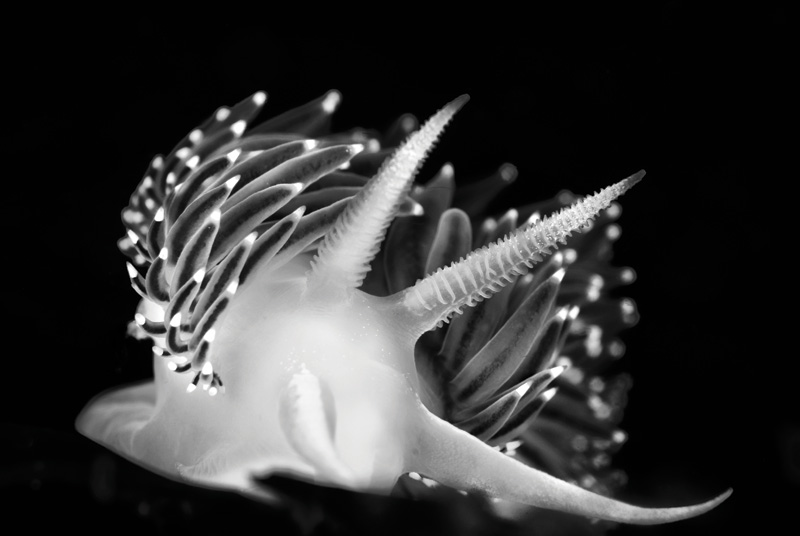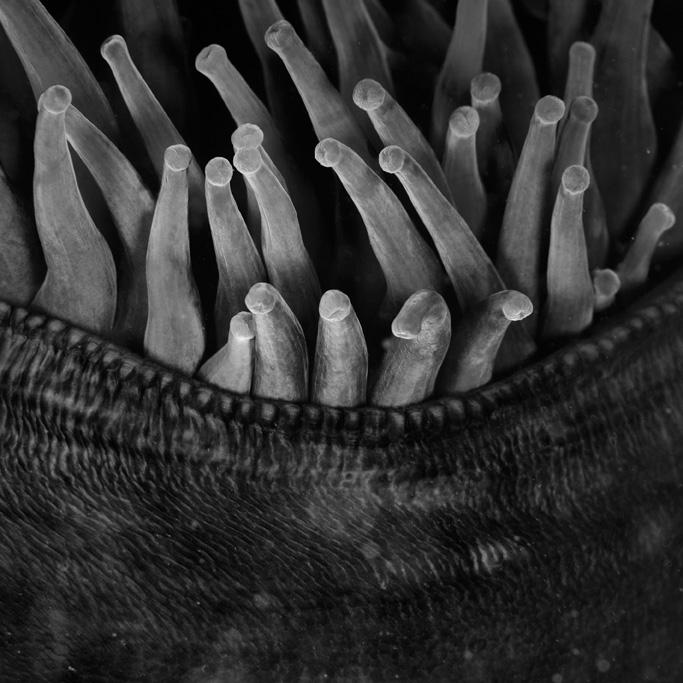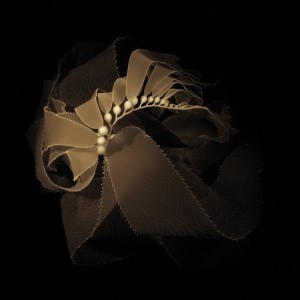California divers get to experience some of the world’s best reefs with an abundance of colorful and diverse subjects to photograph and enjoy. However, some scenes take on new life and have more impact when presented without color. There is more to creating powerful black and white images than simply converting them to grayscale. Here are a few tips to improve your chances of capturing the timeless and classic look of monochrome.
Light and Shadow
A good photograph whether color or black and white, requires a strong composition, dramatic lighting, and an interesting subject. But when photographing for black and white, knowing how a subject will look without color is very important. Since the essence of monochrome is light and shadow, look for light subjects against dark backgrounds and vice versa. In California, we have an abundance of critters fitting this description. Silhouettes also make excellent black and white images, just remember to turn off your strobes or point them in a manner that eliminates the chance for backscatter. Also, be aware that colors which contrast well together, like a red fish against green water will appear flat and lack contrast in black and white. This is because red and green have similar grayscale values. Blue water, however, contrasts amazingly well with red. With experience, you will learn to differentiate colors and their associated grayscale values to make better choices when shooting for monochrome.
Patterns, Textures, Lines, and Shapes
Monochrome images work especially well with patterns, textures, lines, and shapes. Try and photograph subjects containing one or more of these elements. In California, look no further than the kelp forest to find an abundance of subject matter. The kelp forests themselves are a great example of lines and make excellent silhouettes. Even the blades and floats are photogenic with their variety of textures, detailed edges, and repeating patterns. When photographing the kelp forest, be aware of the sun and try to include it in the frame to add a focal point and help silhouette the kelp stalks. Let’s not forget the macro subjects either. Nudibranchs and anemones, such as the fish-eating Urticina piscivora and club-tipped Corynactis californica, both have all the right characteristics to truly shine in monochrome.
Lighting and Technique
Controlling light using your strobes, camera settings, and angles can go a long way in creating more effective monochrome images. Attempt to frame your subject against open water and use the fastest shutter speed your strobes will sync with. This can help create a dark background to contrast with your strobe lit subject. Another technique involves shooting downward to reduce ambient light on bright days. Although counterintuitive to the cardinal rule of always shooting up, this works quite well with kelp detail shots when a black background is desired. This works quite well for kelp shots and gives the appearance that it is emerging from the darkness. Try different strobe angles as well. When shooting macro, using a single strobe off to one side can help create natural looking shadows and contrast. If using two strobes, set one to provide the main source of light and a second strobe at a much reduced power. As well, turning your strobes inward for some side lighting can help reduce a distracting background and put the emphasis on your subject.
Camera Settings and Software
Although most modern cameras offer the ability to shoot in monochrome, JPG shooters should stick with color in order to preserve as much information as possible for converting your image later in software. Shooting RAW offers the advantage of instant feedback in black and white without sacrificing the original color. When it comes to image editing software, Adobe’s Lightroom and Photoshop still offer the most flexibility. Both have numerous ways to convert your color image to monochrome with some of the best results and precision control coming from the Channel Mixer and the Black & White adjustment tools. Third party plug-ins such as Alien Skin’s Exposure and Nik’s Silver Efex Pro offer users a wide variety of film styles to mimic, grain and vignette control, the addition of colored filters such as red, green, or blue as well as the ability to add various tones to your image such as copper, sepia, selenium, and more. These can be invaluable tools for having the ultimate creative control.
So next time you are out diving with your camera, try not to get distracted by all the blazing colors and hone your eye towards a world of light and dark, textures and shapes, patterns, and lines. An entirely new world exists for your images in monochrome.
Words & Photos by Jim Patterson
Visit Jim’s website at jimpattersonphotography.com



